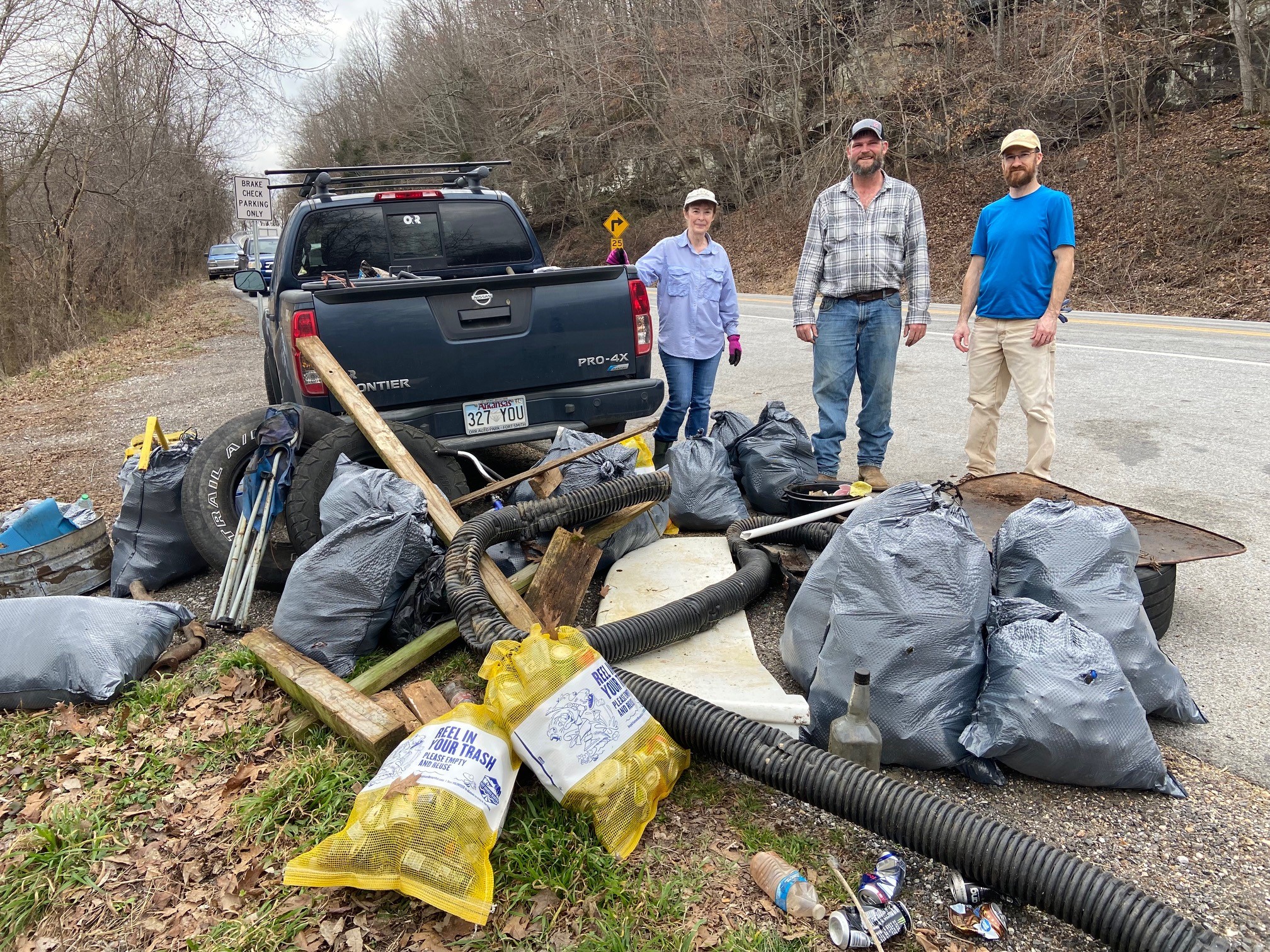Restoration volunteers remove 526 pounds of trash from Buffalo National River watershed site
March 1, 2024
By the U of A System Division of Agriculture
Fast Facts:
- Buffalo River Watershed Enhancement Project participants removes 526 pounds of trash
- Dumpsite litter audit findings similar to watershed litter audit
- Litter audit is a recommendation in the Buffalo River Watershed Management Plan
(744 words)
(Newsrooms: Download graphics and photos.)
FAYETTEVILLE, Ark. — Even the country’s first National River can find itself the unfortunate victim of illegal dumping, especially as it winds its way through some of the most scenic areas of Arkansas.
On Feb. 22, members of the Cooperative Extension Service and the Nature Conservancy, along with local landowners and volunteers, removed 526 pounds of illegally dumped trash in the upper reaches of the Buffalo National River watershed. The site was located along Highway 21, near Smith Creek Nature Preserve.
The dumpsite was found as part of a litter audit — part of the Buffalo River Watershed Enhancement Project — conducted by the Cooperative Extension Service. Part of the project’s mission is to conduct outreach throughout the watershed area and foster support for the Buffalo River Watershed Management Plan, which will in turn improve water quality in the watershed.
John Pennington, extension water quality educator for the University of Arkansas System Division of Agriculture, said the dumpsite audit showed that the largest percentage of trash by weight was metal, followed by tires, hazardous paper waste and plastic. E-waste, textiles and furniture, glass and wood were also found. Approximately 70 percent of the waste removed from the cleanup was recycled. Cash for the recycled metal totaled $15, which will be put into local 4-H litter removal and recycling efforts.
“The dumpsite we cleaned up was not old or historic like some dumpsites,” Pennington said. “This dumpsite, like many other dumping sites around the state was newer. It will be interesting to see if the dumpsite continues to be used now that it has been cleaned up. The ongoing litter audit throughout the watershed will be able to monitor the littering and dumping rate in the areas.”
The 2023 Buffalo River litter index audit examined eight publicly accessible locations, spanning from the headwaters along Highway 21 down to the Rush access point. It revealed that tires and textiles were the largest items of trash found by weight, with hazardous waste paper, glass, metal and plastic being commonly found.
“The good news is that all but one of the locations surveyed had less than a pound of trash found at each of them,” Pennington said. “The low amount of trash found at most litter audit sites is likely due to the efforts of local landowners, the National Park Service and visitors doing their part to keep the watershed healthy and clean.”
To participate in future litter audit or voluntary water quality improvement activities as part of the Buffalo River Watershed Enhancement Project, visit https://www.uaex.uada.edu/environment-nature/water/buffalo-river-project.aspx.
The Cooperative Extension Service has partnered with multiple agencies and organizations, including lead partner The Nature Conservancy, the U.S. Department of Agriculture’s Natural Resources Conservation Service, Arkansas Forestry Division, Buffalo River Conservation District, Searcy County Agricultural Conservation Cooperative, Searcy County and the Arkansas Game and Fish Commission. The partnership project makes hundreds of thousands of dollars in conservation practice funding available to landowners participating in the project each year. To learn more, and if you are a landowner in need of conservation assistance funding, contact your local NRCS service provider and sign up for the Buffalo River Watershed Enhancement Project.
For more information on water quality, watersheds, Arkansas Watershed Stewards Program or the Buffalo River Watershed Regional Conservation Program, check in with your local county extension office.
To learn about extension programs in Arkansas, contact your local Cooperative Extension Service agent or visit www.uaex.uada.edu. Follow us on Twitter and Instagram at @AR_Extension. To learn more about Division of Agriculture research, visit the Arkansas Agricultural Experiment Station website: https://aaes.uada.edu/. Follow on Twitter at @ArkAgResearch. To learn more about the Division of Agriculture, visit https://uada.edu/. Follow us on Twitter at @AgInArk.
About the Division of Agriculture
The University of Arkansas System Division of Agriculture’s mission is to strengthen agriculture, communities, and families by connecting trusted research to the adoption of best practices. Through the Agricultural Experiment Station and the Cooperative Extension Service, the Division of Agriculture conducts research and extension work within the nation’s historic land grant education system.
The Division of Agriculture is one of 20 entities within the University of Arkansas System. It has offices in all 75 counties in Arkansas and faculty on five system campuses.
The University of Arkansas System Division of Agriculture offers all its Extension and Research programs to all eligible persons without regard to race, color, sex, gender identity, sexual orientation, national origin, religion, age, disability, marital or veteran status, genetic information, or any other legally protected status, and is an Affirmative Action/Equal Opportunity Employer.
# # #
Media Contact:
Ryan McGeeney
rmcgeeney@uada.edu
@Ryan_McG44
501-671-2120
